Today's customers have many purchasing options, such as shopping in-person, curbside pickup, using home delivery services provided by physical and virtual stores, and online marketplaces such as Amazon and eBay. But, when it comes to buying online, one of the very unusual, quite convenient, and the only variant with the surprise element came in the form of - 'subscription boxes.'
A niche market compared to the conventional retail sector, subscription boxes offer recurring physical delivery of carefully curated products to specific target audiences. Customer retention is one of the essential business objectives for subscription boxes. And that is why the e-commerce companies providing these boxes put the effort into cultivating a long-term relationship with a person signing up for their services.
GoodFirms surveyed 510 people across the globe to know about their take and usage of subscription boxes. The findings provide insights into subscription box industry analysis - overall penetration of e-commerce box services into customers' lives, the demographics, the number of active boxes the consumers have, their favored products, spending every month, and reasons for subscriptions and cancellations.
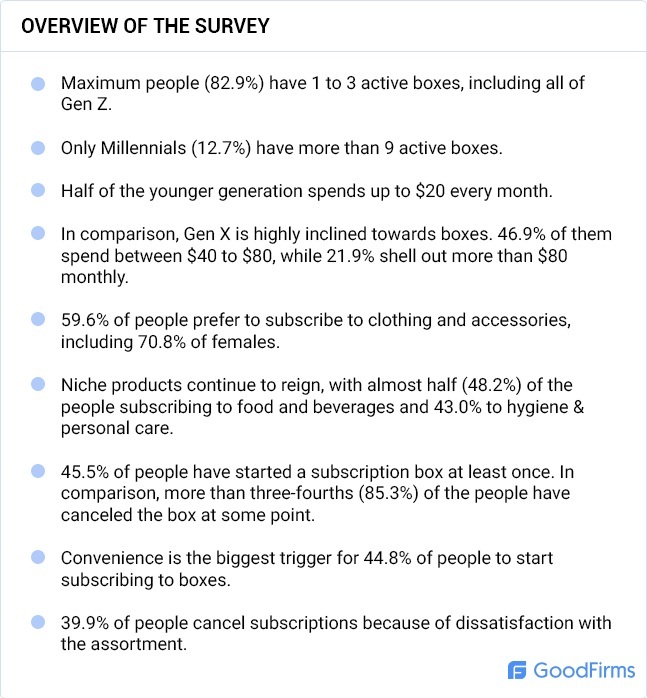
The Detailed Findings
Customers across the globe have been sticking strictly to the necessities during the current pandemic, particularly in the early months. Yet, the subscription sector has used these uncertain times to innovate further, adjust and offer convenience and predictability to its customers.
45.5% of the surveyed participants have started a subscription box at least once. And 37.8% of people are currently subscribed to the boxes. The subscription model is becoming ubiquitous and offers immense variety with convenience. It is clear that the subscription box model still has a lot of untapped potential.

GoodFirms surveyed to know the factors that trigger the subscription for today's customers and the elements that hold them off and compel them to unsubscribe boxes.
People Have Up To 3 Active Box Subscriptions
In 2004 came the earliest-known subscription box - The Sampler. It mailed samples of products from crafters, independent web-based artists, magazines/fanzines, and shops.
But the subscription box sector started getting attention with the establishment of Birchbox in 2010, soon followed by Dollar Shave Club and Ipsy. Now, after a decade, the industry has expanded well beyond razors and beauty products, delivering everything from toys to dog treats to plants and even materials for jewelry making. More than 22% of the subscription box companies have seen growth in subscriber acquisition rates in 2020.
The rapid rise of the subscription boxes and huge growth potential has prompted big brands like Amazon, Walmart, Sephora to launch their own subscription schemes. Numerous SMBs are also starting subscription box services to take advantage of significant opportunities for international expansion.
The survey reveals that the majority of the subscribed people (82.9%) have up to 3 active subscription boxes, while only 7.8% have currently subscribed to more than 9 boxes.

One of the most remarkable points here is - all of Gen Z has a maximum of 3 active boxes. Another interesting fact is that only millenials, 12.7% of them, have signed up for more than 9 boxes!
Generational Differences Affect Buying Behavior
Each generation has its unique perspective and cultural traits that characterize their shopping habits. There is an apparent difference in how a 21-year-old college student purchases from how a 65-year-old mostly retired grandparent buys. And in the present oversaturated online market, finding the right customers through purchasing habits data is crucial for a subscription box company's success.
The survey reveals that 67.3% of the subscribed people spend up to $60 every month on subscription boxes. While about 32.7% spend more than $60 every month on subscription boxes.

Half of Gen Z spends up to $20 every month on subscription boxes.
In 2020, Gen Z constituted 40% of all consumers in the U.S. and Europe. This generation of digital natives might have smaller pockets than the older generation, but their influence is mighty. 50.0% of the subscribed Gen Z spends up to $20 every month on the subscription boxes.
As this generation can't remember a time before the internet, online platforms have become the foundation of their shopping practices. This can be advantageous for subscription companies with perfect marketing strategies.
Even as 100% of Gen Z has a maximum of 3 active boxes, 25% of them shell out more than $60 every month on the boxes. Meaning, they do not hesitate to spend more on the brands they take fancy to.
Generation with more disposable income spends maximum.
With age, people's spending and saving patterns change. Diverse, savvy, and self-reliant Gen Xers are into their prime spending years. According to the GoodFirms survey, this generation spends maximum money on subscription boxes. 40.7% of Gen X spend more than $60 per month.
As Gen X is experienced with purchasing both online and in-store, subscription box companies have to be strategic with how and where they market to this audience.
Meanwhile, Millennials fall somewhere between Gen Z and Gen X regarding purchasing, with 29.7% of them spending more than $60 monthly on subscription boxes. For Millennials, brands matter, but they see right through fake, and so businesses need to be authentic and transparent to win over them.
Niche Products Continue to Dominate Box Subscriptions
Kids, teens, wine enthusiasts, foodists, fashion enthusiasts, pet lovers, etc., all have a range of subscription boxes to choose from. Receiving a wide variety of products each month, tailored around their requirements or interest, is fun and exciting for most people. By doing it right, a business endeavor based on subscription boxes can be quite profitable.
The survey has disclosed that 59.6% of the consumers have subscribed to boxes for clothing & accessories. Food & beverage subscription boxes have been in high demand, too, with 48.2% of the consumers subscribing to them.

Hygiene & personal care, beauty & makeup, books, home & living, are also among the crowd favorites. Subsequently, many subscription box brands have also been able to grow their customer bases during this challenging time.
Sourcing for quality products can be challenging at times. Subscription box companies can source their products from local stores, niche e-commerce websites, search engines, global marketplaces, vendor networks, a marketplace for mostly small-/medium-sized businesses(Etsy), and wholesale from big brands.
There are 2 main ways for subscription companies to fill the boxes.
-
Customers subscribe for Replenishments: Here, businesses can create the boxes by assembling products that attain an existing need within a particular niche. When designing a product concept, companies need to think about how they can solve a problem found in day-to-day life while ensuring the box makes sense for scheduled deliveries.
Dollar Shave Club is a perfect example of a successful subscription business that solves a problem by offering quality products needed regularly. Companies can use Google Trends to explore current trending products and topics.
-
Customers subscribe for Curation: Here, customers receive items specially curated for them based on their interests and requirements. A company that deals with the products exactly like another subscription box has to compete on price and might forever be in a price war with its competitors. Besides, as customers are signing up for more than one monthly box, it is essential to come up with fresh and new items with each and every delivery. Having a box with the same products that customers have already received earlier can be a major turnoff.
Many customers want to see and experience products before buying. Subscription companies can give customers a chance to try new products by filling the boxes with smaller sample sizes of new products, like the makeup subscription box service Ipsy does. Later, they can enable discounts on purchases of full-size versions of products.
Consumers Appreciate the Convenience and Flexibility to Cancel
Convenience is not just limited to recurring 'auto-delivery.' It holds a different meaning for every individual. Some consumers are looking for the cheapest available option without any inclination for delivery speed, while others require it faster and are willing to pay more for an efficient service. So, ultimately convenience is about the ease with which subscription boxes solve their customers' problems. The brands must convey that their services go far beyond delivering easy meals, beauty products, or workbooks.
44.8% of the consumers cite 'convenience' as the reason for subscribing to the boxes.

Delivering a convenient customer experience from beginning to end is quite essential. Busy shoppers want to have items delivered hassle-free, often without having to wait for them at home. So, companies need to provide flexible timings and can think of offering options such as letterbox delivery. Brands like Garçon Wines, with its pioneering, flat wine bottle, are innovating ways to respond to this need.
'Flexibility to cancel' is a factor that triggers 25.4% of the customers to sign up for the boxes. Understanding the current climate and pivoting accordingly is the key. For example, Barkbox(a box filled with dog toys and treats) has let customers pause their subscriptions until they 'feel more secure about their finances.'
"The timing and control over the contents of the box are as important. Many companies fail to invest properly in the technology needed to close that customer service loop," says John Ostler, CEO of Unicorn Road.
He adds, "In a monthly subscription model, sometimes we wouldn't get through all the contents of the box. We didn't want to cancel but needed to delay receiving the next box, which wasn't easy. Unused boxes lying around led us to cancel. There are other instances in a weekly subscription model where the selection process was hard to alter. In both instances, it left us feeling disconnected from the delight of receiving a box."
Consumers appreciate the brands and feel a sense of loyalty when they show understanding and offer the flexibility to pause subscriptions or delay payments temporarily.
Subscribers Expect Subscription Boxes to Provide 'Value For Money'
Giving customers value for their money is central to any business' success. For people, it does not necessarily mean a low price. Instead, it is about having a better quality of products in more suitable quantities, just in time when needed. When customers feel that the products they receive in subscription boxes are worth more to them than the money in their wallet, they will subscribe.
34.1% of the people credit 'value for the money' as a trigger to subscribing to the boxes. At the same time, 29.8% acknowledge 'lack of perceived value' as the reason for canceling!

Evaluating and re-evaluating the products' price is one of the most critical decisions for the subscription box business's success. Often, a value proposition for customers means clear savings on the price they pay versus the products' total retail value. It has become a common habit of subscription box customers to research the products they receive to tally up and confirm the total retail value.
There are various things to consider when pricing a subscription box for maximum revenue. Entrepreneurs need to study hard numbers and also consider softer elements such as pricing psychology.
As the subscription box market continues to expand, businesses have the advantage of gathering information from their competition to find out how to improve the products without negatively affecting the bottom line.
Subscription Box Pricing Examples -
- Birchbox - one of the glam beauty subscription boxes - $15 per month
- FabFitFun - full-size products in beauty, fitness, wellness, home, and many more - delivers themed boxes each season - $179 per year
- Loot Crate - a t-shirt and more licensed and exclusive items for geeks and gamers - $19.99 per month
Quality of Products Is the Key to Customer Experience
Quality is mainly about offering products exceeding the standard. Essentially, such items provide subscribers a positive experience and help build brand loyalty. Customer retention is critical for any subscription box company as even a small percentage of shoppers unsubscribing each month can have a considerable impact on their subscriber base.
When dissatisfied with the product quality, 32.8% of the unsubscribers tend to cancel the subscription.
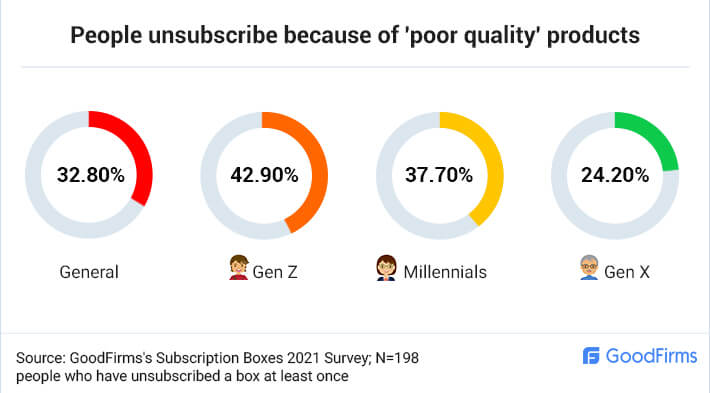
A high-quality product has to be polished, easy to use, and tailored to the customers' needs. Also, it must efficiently solve their problems. As subscription companies are mostly niche-specific, they need to ensure proper quality to set their products apart from the competition.
With an effective quality-control system in place, subscription companies can determine the root causes of nonconforming products and retest them after reworking.
Competitive Advantage Can Be Achieved With 'Assortment Of The Products'
With many businesses providing similar kinds of products, a company sending properly assorted items can stay ahead of the competition. Curation can be considered as a precise science. Here companies need to predict which items their customers will like. 39.9% of the unsubscribers tend to cancel the subscription when they are dissatisfied with the assortment.
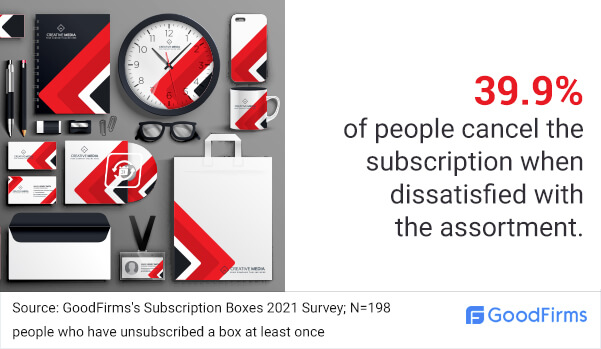
As each box is unique, subscription box companies need software that tracks each customer's box and provides employees with the data to fill it appropriately. Artificial intelligence helps understand different touchpoints and offers invaluable insights into consumer preferences, which can then be used to assort the products.
Though just knowing the subscribers' inclination is not enough. The subscription companies need to acquire the resources and experts with the best knowledge of their products too. For example, Bean Box works with small-batch, independent roasters to ensure that coffee lovers receive thoughtful, high-quality blends in every box. Subscribers have different options to select from light, medium, dark, decaf roasts, whole beans, or ground.
Likewise, Snack Box, Universal Yums delivers sweet and salty snacks from different countries every month, along with the facts, recipes, and a scorecard for tracking subscribers' favorites.
Subscription box companies can also partner with celebrities as products curated by them work quite well when the targeted audience is influencer-obsessed. Renowned actress Kate Hudson has co-founded Fabletics, health enthusiasts' favorite source for high-quality fitness, yoga, and running gear. Demi Lovato is also closely associated with the brand.
Online Reviews Lay The Groundwork For Success
Merely advertising and letting customers know about the products is no longer enough; customers crave knowledge from first-hand experiences. They are more likely to subscribe if others around them, even total strangers, agree that the products in the boxes are worth investment.
19.8% of people, including 30.0% of Gen Z, consider online reviews while subscribing to the boxes.
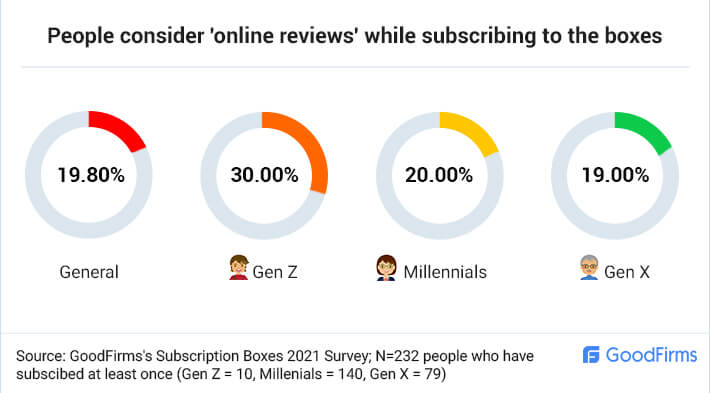
A mixture of positive and negative reviews gives any company authenticity. Only excellent reviews lead customers to suspicion. Disregarding online customer reviews can be a big mistake for subscription companies. In addition to providing credibility and pulling in the subscribers, reviews can be used for useful analysis. By identifying problem areas, subscription box companies can proactively improve their business and make adjustments to how they curate, fulfill, and market boxes.
But with a substantial number of reviews posted each day, most major brands cannot analyze every customer reaction individually. Instead, many brands have started using artificial intelligence to extract and analyze the sentiment/information from product reviews. Some of the platforms offering AI technology for analyzing customer feedback posted online are Lexalytics, SentiGeek, etc.
Besides online reviews, subscription companies can be proactive and try to collect feedback from their customers. For this, they can use 3rd party services to accumulate more granular data around their products, such as individual product feedback, other details about subscriber experience (shipping, customer support, etc.). Some of the examples of customer feedback tools include HubSpot, SurveyMonkey, ProProfs, and more.
Experimental Gen Z Listens To Recommendations
The younger generation is not that conservative about where, how, and what they shop. It is more open to experimenting with contemporary knick-knacks or novel fragrances or flavors. Our research suggests that Gen Z is the most experimental demographic. 70.0% of them got inclined to subscription boxes because they wanted to try something new!
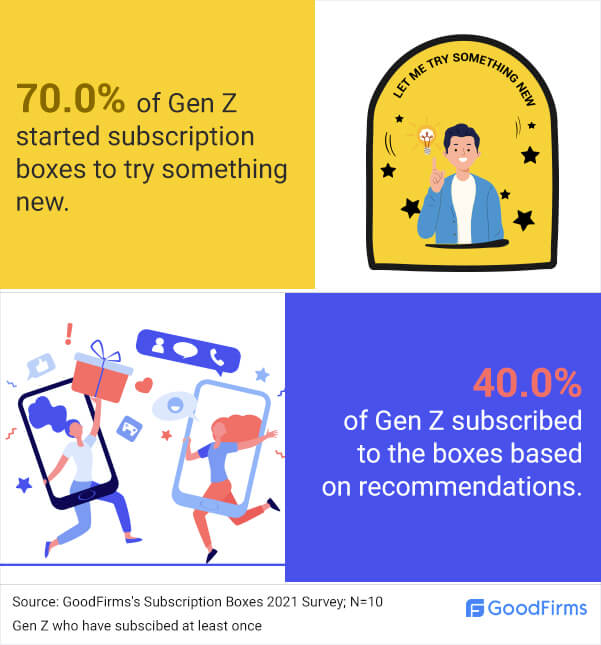
Subscription box companies need to be innovative to captivate the attention of the first generation to be purely born into the digital world. Also, 40.0% of the younger generation values recommendations from friends and family when subscribing. Not only that but Gen Z also actively participates in spreading the word about the brands they really get inclined to.
The most obvious way for subscription companies to increase their subscriber base is by offering referral incentives. For example, Dollar Shave Club (DSC) runs a Referral Program, which allows members to earn promotional credits for a future purchase of products by referring their friends, family, or other individuals to DSC.
Another way to spread recommendations by word of mouth is to launch campaigns and create a genuine buzz about the boxes with impartial people mentioning the company's products on social media.
Perfecting The Unboxing Experience Has Become Must-have
The boxes' subscriber base also covets a memorable 'unboxing' experience that includes bespoke packaging, attractive inserts, and trendy boxes. 20.3% of the subscribed people value 'personalized experiences', 10.3% prefer 'surprise factor', and 7.8% appreciate 'exclusivity'.
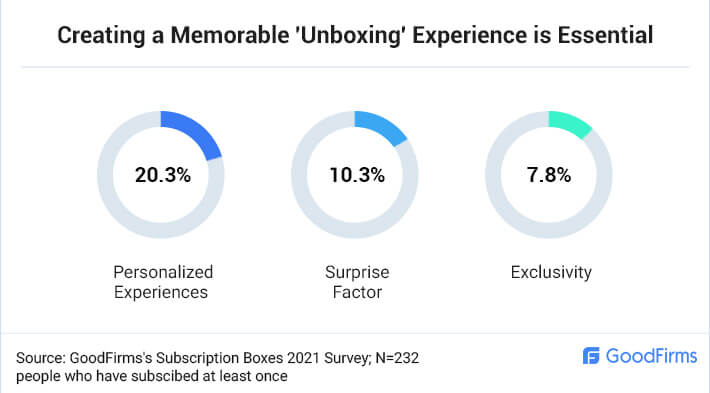
Well-assorted products, along with premium printing and unique packaging, provide an excellent unboxing experience. Subscription box companies must select a custom packaging manufacturer that can create a unique design, the best boxes, and handle all printing needs.
When incorporating gradients, large blocks of color, striking, pearlescent, metallic, or holographic materials, bold and appealing fonts are popular. Many YouTube creators have a massive following for their unboxing videos that record their reaction to the contents of that month's box. These videos certainly provide transparent human validation and a glimpse at the products that are not mediated by the brand.
By utilizing these live-action videos, the subscription companies can boost their content marketing efforts, drive engagement, grow a customer base, and increase sales.
Conclusion
Post pandemic, subscription boxes have matured a lot as a business model. The industry is utilizing this unique time to meet the increased demand for personalization and convenience and establish long-term relationships with the subscribers. The ultimate winning strategy of subscription box businesses is to exceed their subscribers' expectations while making the most profit.
For this, they need to deliver high-quality products on time and have exceptional customer service. As there cannot be an official definition of great experience, it is more important to understand the customers' unique desires and needs. And because subscription boxes target particular niche markets, companies must aim to create buyer profiles to uncover their ideal customer's lifestyle, motivation, and purchasing behavior. Ultimately, this information will help them determine a marketing strategy and accurately price the subscription to stand out from the crowd.
Companies need to make customers believe that they're getting a good deal on the products in their box. Ultimately, a subscription box with the products looking great together, the aesthetics of the branding, labels, and color choices, can go a long way.
About Goodfirms's Subscription Box Survey
GoodFirms surveyed 510 consumers worldwide.
The respondents of the survey belong to various socio-economic geographies such as the United States (36.9%), India (15.9%), Canada (13.7%), Australia (7.6%), Ukraine (4.1%), and Others (21.8%).
The participants were males (67.1%), along with females (32.2%). Also, the age distribution among all the research contributors was - 7.5% of Generation Z (18-24), 59.2% of Millenials (25-39), and 31.6% of Gen X (40-59).
We sincerely thank our Research Partners to help us garner participants and give a peek into today's consumers' mindset.
* For any queries, drop an email to [email protected]
- 365 Digital Consulting
- A-HR
- A2 Design
- A2 System Mobile,Research
- A2ZVA
- Abhigamyah Technovations
- Absolute Digital
- Ace Infoway
- Actupon Technologies
- Adastra Bulgaria
- AddWeb Solution
- AdEngage
- Adept Technologies
- Adimen
- Adsum Originator
- Advanced Analytics and Research Lab
- AdzGuru
- Affluence PR
- Ajinkya Global Adventure
- Aksoy Araştırma
- ALL-PRO Bookkeeping Services
- Altoros Labs
- Amptize
- Anderson Collaborative
- AndLeads
- Angle2
- AntStack Technologies Pvt Ltd
- Apero Solutions
- Apify
- Applover
- AppMomos
- Appssemble
- APPVALES
- Arcadia Bytes
- Argona Partners
- ARNSS Innovation
- Ascii System
- Askgalore Digital
- Asterism Infosoft Pvt Ltd
- Atma
- Aveshost
- Aymen Jarouih
- BABEL Agency
- Bastion Elevate
- BD Server Hosting
- Bespoke Design
- Best Heads
- BKA Content
- Blaize
- BrandDad Digital
- BrandGeko
- Breadnbeyond
- BroSolutions
- Brounie
- Bungarra
- Candor
- Carver Cantin and Mynarich
- Cascadia Training
- CCC International
- Ceemi Agency
- Central Hubspot
- Chowdhury Aktar & Associates
- Ciel Consulting
- CIENCE
- COAX Software
- CodeCoda
- Codepxl
- CoderKube Technologies
- Codility Solutions
- Commercial Translation Centre
- Contact 1-2-1
- ConvrtX
- Coquewebsite
- CosmoDoggo
- Curve
- Dapgen Technology Private
- DataGators
- DenBe Computer Consulting
- Design Start
- Dgmark Agency
- Digiadlab
- DIGITAL OPERATIVE
- Digital Partner
- Digital Third Coast
- DigitalDesign.NYC
- Dignexus
- dion
- Dividato
- Dixtra
- DNA DIGITAL MARKETING
- DNAVI
- Docforce
- DQM Software Inc.
- DreamWalk Apps
- Duckpin
- E-Vision Corp
- Eastern Peak
- echoinnovateit
- Eco Web Hosting UK
- eContentsol
- Ecotech IT Solutions
- Elecsis
- Elite Graphix
- Elite TransLingo
- eMarspro.Inc
- Eminenture
- Empex Digital
- EmpowerD Tech
- Eptins
- Equinox Information Services
- eSEOspace
- Espay Exchange
- Evernetica
- Excelify Solutions
- Excite Media
- Firewire Digital
- Fisheye Solutions
- FlareMark
- ForwardSprint Consulting
- Frontier Consulting
- Gamajun Games
- Genuineq
- Glenn Website Design
- Goldenlink Digital Media
- Gorrion Software House
- GOTO MARKETERS INC
- GoWebLive
- Greek Mapple
- Groove Jones
- Growth360
- Growwwise
- Gustonera
- Hexis Technology Hub
- HireTester
- Hitz Digital Marketing
- HypeLife Brands
- IBR Infotech
- IBR Infotech
- IceVayne Games
- Ideofuzion pvt ltd
- IllustReign IT Solution
- Imagine
- IMTC
- Inclusion The Cloud Company
- India Blockchain Alliance
- INETWORK Middle East
- Inflexion Software
- INGCO International
- Innovatily
- Invisible Ink
- Jacobs Development
- JaxonLabs LLC
- JDV Technologies
- Ji Web Lab Solutions
- JP Web Agency
- Lafont Innovation LLC
- Lanka Designer Solutions (Pvt) Ltd
- LanSoft
- LatAm Intersect PR
- Lead Tycoons
- Leading Solution
- LiaisonIT INC
- Lift Digital Marketing
- Light-it
- Liventus
- Lizard Global
- LMNts Marketing
- Magicmind technologies Limited
- Magister Marketing and Consultancy
- Marketing Launch Team OÜ
- MastakStudio
- Medwave Billing & Credentialing
- Meerkat Marketing
- MegaZebra
- Meson Digital Marketing Agency
- Microad Blade Indonesia
- Mindshare Labs, Inc
- Mintosoft
- MobMaxime
- MOST 2414
- Mylestone HR Consulting
- N-Development
- NDIMENSION LABS
- Neev Pathar Architects & Interior
- Neklo
- Neotech Solutions
- Nivahata Technologies
- Novasta Bilişim Ltd.Şti
- OpenXcell
- Optimize Goal
- ORIMOS.DEV SRL
- Outsource in Pakistan
- Pairroxz
- PengYi Labs
- Pepper Interactive Communication
- Pharos Softtech Private Limited
- Phoenix Training and Development
- Photozland
- Pixelfly Innovations Pvt Ltd
- Prometeo
- Psybrtech Initative
- Pulsar
- quality.code
- Rambhapuri Technologies
- RAVE
- RavSam Web Solutions
- Ridgemax Solutions
- Risivonne Investments
- RW Infotech Private Limited
- sA.design
- Sahal Accounting Services
- SaM Solutions
- SBR Technologies
- Scalan Labs, LLC
- SEO Kings
- SEOCompanyinDelhi.net
- ServerGuy
- Seven Boats Info-System Pvt. Ltd
- Shape My Content
- Shopify Pro New York
- Shyena Tech Yarns Pvt Ltd
- Sibers
- Siddhi Infosoft
- Silicon Graphics
- SIPSA
- SJ Solutions & Infotech
- SJ Solutions & Infotech
- Smart Voice Studio
- Softpulse Infotech
- Solid Hosting South Africa
- SOLUNTECH
- Solution Mentors Inc.
- Sorcible
- Sosene Company Limited
- Spica Technologies Ltd
- StableWP
- SunHouse Marketing
- Superb Digital Limited
- Supplyant
- Sure Oak
- Tech ICS
- Techamic Solutions
- TECHDesign
- TechDilation
- Technoton Engineering
- Techxide
- THATWARE LLP
- The Evenstar
- The Franatics
- THE MANPOWER COMPANY
- The Telemarketing Company
- Thoroughbred Solutions
- Tiger Systems Ltd
- Tigerfish Software
- Trilight Security
- True Tech Professionals
- Tsukiden Global Solutions Inc.
- TUCU Managed IT Services Inc
- UBX Cloud
- UKR Shipping LLC
- Ultimate Systems
- Unicorn Road, LLC
- Valen Digital
- Velvot Nigeria Limited
- Venum Agency
- Vidhema Technologies Pte Ltd
- Visualwebz
- Volumetree
- Volumetree
- Votan Ventures
- VTI Cloud
- Vuemobi Local Marketing
- Web Masters Technologies
- WEB-RECRUITERS
- webbingstone
- WeDevlops.com
- Well Made Software
- WeSoftYou LLC
- Zencode Technologies Pte Ltd
- ZXSCRIPT




